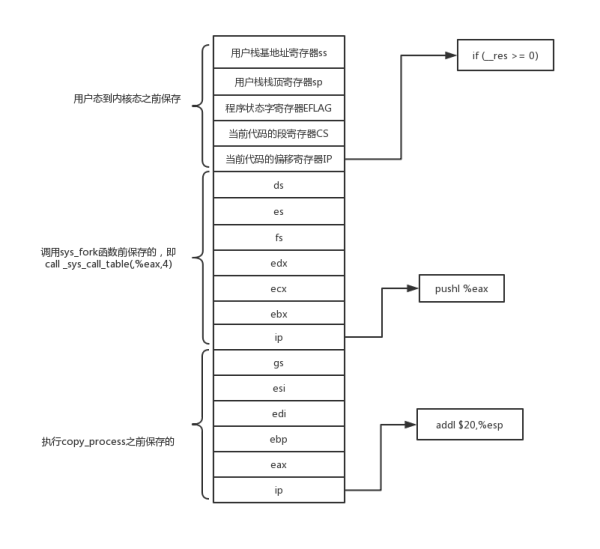首先看一下fork函数的定义。
static inline _syscall0(int,fork)
#define __NR_fork 2
#define _syscall0(type,name) \
type name(void) \
{ \
long __res; \
__asm__ volatile ("int $0x80" \
// 输如输出都是eax,输入是系统调用函数在系统调用表的序号
: "=a" (__res) \
: "0" (__NR_##name)); \
if (__res >= 0) \
return (type) __res; \
errno = -__res; \
return -1; \
}
fork函数利用int 80触发中断。在sched.c里注册了该中断的处理程序。
set_system_gate(0x80,&system_call);
所以执行fork函数就会执行system_call函数,但是在这之前,还有些事情需要做,就是保存现场。下面是操作系统执行系统调用前,在内核栈里保存的寄存器,这个压入的寄存器和iret中断返回指令出栈的寄存器是对应的。其中ip指向的是调用系统调用返回后的下一句代码。

继续看一下system_call的代码。
.align 2
bad_sys_call:
movl $-1,%eax
iret
.align 2
reschedule:
pushl $ret_from_sys_call
// 执行schedule
jmp _schedule
.align 2
_system_call:
// 比较参数,不合法的参数直接返回中断,错误码是-1
cmpl $nr_system_calls-1,%eax
ja bad_sys_call
// 寄存器压栈,保存现场和用户传递的参数
push %ds
push %es
push %fs
// 执行系统调用的函数时用户传入的三个参数,右到左,ebx是第一个参数
pushl %edx
pushl %ecx # push %ebx,%ecx,%edx as parameters
pushl %ebx # to the system call
// 0x10是内核数据段的选择子
movl $0x10,%edx # set up ds,es to kernel space
mov %dx,%ds
mov %dx,%es
movl $0x17,%edx # fs points to local data space
mov %dx,%fs
// 根据参数,从系统表格里找到对应的函数,每个函数地址4个字节
call _sys_call_table(,%eax,4)
// 系统调用的返回值,压栈保存,因为下面需要用eax
pushl %eax
// 把当前进程的pcb地址赋值给eax
movl _current,%eax
// 判断当前进程状态,0是可执行,即判断当前进程是否可以继续执行
cmpl $0,state(%eax) # state
// CMP结果为0则zf等于1,jne是cf为0则跳转,所以下面是当前进程state不为0,则跳转,即重新调度
jne reschedule
// 时间片用完则重新调度
cmpl $0,counter(%eax) # counter
je reschedule
ret_from_sys_call:
movl _current,%eax # task[0] cannot have signals
// 判断当前执行的进程是不是0号进程
cmpl _task,%eax
// 是的话跳到标签3
je 3f
cmpw $0x0f,CS(%esp) # was old code segment supervisor ?
jne 3f
cmpw $0x17,OLDSS(%esp) # was stack segment = 0x17 ?
jne 3f
// 把这两个字段赋值给寄存器
movl signal(%eax),%ebx
movl blocked(%eax),%ecx
// 对block变量的值取反,即没有屏蔽的为变成1,表示需要处理的信号
notl %ecx
// 把收到的信号signal和没有屏蔽的信号,得到需要处理的信号,放到ecx中
andl %ebx,%ecx
/*
Bit Scan Forward,如果ecx等于0,则cf等于1,否则cf是0
从低位到高位扫描ecx,把等于第一个是1的位置写到ecx中,即第一位是1则位置是0
*/
bsfl %ecx,%ecx
// cf=1即ecx是0则跳转,代表没有需要处理的信号则跳转
je 3f
// 把ebx的第ecx位清0,并把1移到CF,处理了该信号,清0
btrl %ecx,%ebx
movl %ebx,signal(%eax)
// 当前需要处理的信号加1,因为ecx保存的是位置,位置是0开始的,信号是1-32
incl %ecx
// 入参压栈
pushl %ecx
// 执行信号处理函数
call _do_signal
popl %eax
3: popl %eax
popl %ebx
popl %ecx
popl %edx
pop %fs
pop %es
pop %ds
iret
函数比较长,分段分析,首先看到call _sys_call_table(,%eax,4)这一句。这时候,内核栈是

因为是段内跳转,所以cs不需要入栈。ip指向call _sys_call_table(,%eax,4)下面一句代码。我们首先进入call _sys_call_table(,%eax,4)里面看。
fn_ptr sys_call_table[] = { sys_setup, sys_exit, sys_fork, sys_read,
sys_write, sys_open, sys_close, sys_waitpid, sys_creat, sys_link,
sys_unlink, sys_execve, sys_chdir, sys_time, sys_mknod, sys_chmod,
sys_chown, sys_break, sys_stat, sys_lseek, sys_getpid, sys_mount,
sys_umount, sys_setuid, sys_getuid, sys_stime, sys_ptrace, sys_alarm,
sys_fstat, sys_pause, sys_utime, sys_stty, sys_gtty, sys_access,
sys_nice, sys_ftime, sys_sync, sys_kill, sys_rename, sys_mkdir,
sys_rmdir, sys_dup, sys_pipe, sys_times, sys_prof, sys_brk, sys_setgid,
sys_getgid, sys_signal, sys_geteuid, sys_getegid, sys_acct, sys_phys,
sys_lock, sys_ioctl, sys_fcntl, sys_mpx, sys_setpgid, sys_ulimit,
sys_uname, sys_umask, sys_chroot, sys_ustat, sys_dup2, sys_getppid,
sys_getpgrp, sys_setsid, sys_sigaction, sys_sgetmask, sys_ssetmask,
sys_setreuid,sys_setregid };
其实是一个数组,根据eax即系统函数的编号找到对应的函数执行。这里我们要找的sys_fork。所以我们继续看sys_fork函数的代码。
.align 2
_sys_fork:
// 执行find_empty_process函数,返回一个进程id在eax里
call _find_empty_process
// 看是否找到可用的进程id
testl %eax,%eax
// 没有找到调用标签1,即返回
js 1f
// 找到则压栈寄存器
push %gs
pushl %esi
pushl %edi
pushl %ebp
// 找到的进程id
pushl %eax
// 继续调函数
call _copy_process
// 出栈上面压进栈的五个寄存器,然后返回
addl $20,%esp
1: ret
sys_fork首先执行find_empty_process函数找到一个可用的进程号。代码如下
int find_empty_process(void)
{
int i;
repeat:
// 先找到一个可用的pid
if ((++last_pid)<0) last_pid=1;
for(i=0 ; i<NR_TASKS ; i++)
if (task[i] && task[i]->pid == last_pid) goto repeat;
// 再找一个可用的pcb项,从1开始,0是init进程
for(i=1 ; i<NR_TASKS ; i++)
if (!task[i])
return i;
return -EAGAIN;
}
找到后把pid放到eax里,返回sys_fork。根据sys_fork的代码,我们看到继续压栈寄存器然后执行copy_process函数。这时候内核栈是

然后我们看copy_process函数的代码。
int copy_process(int nr,long ebp,long edi,long esi,long gs,long none,
long ebx,long ecx,long edx,
long fs,long es,long ds,
long eip,long cs,long eflags,long esp,long ss)
{
struct task_struct *p;
int i;
struct file *f;
// 申请一页存pcb
p = (struct task_struct *) get_free_page();
if (!p)
return -EAGAIN;
// 挂载到全局pcb数组
task[nr] = p;
// 复制当前进程的数据
*p = *current; /* NOTE! this doesn't copy the supervisor stack */
p->state = TASK_UNINTERRUPTIBLE;
p->pid = last_pid;
p->father = current->pid;
p->counter = p->priority;
p->signal = 0;
p->alarm = 0;
p->leader = 0; /* process leadership doesn't inherit */
p->utime = p->stime = 0;
p->cutime = p->cstime = 0;
// 当前时间
p->start_time = jiffies;
p->tss.back_link = 0;
// 页末
p->tss.esp0 = PAGE_SIZE + (long) p;
p->tss.ss0 = 0x10;
// 调用fork时压入栈的ip,子进程创建完成会从这开始执行,即if (__res >= 0)
p->tss.eip = eip;
p->tss.eflags = eflags;
// 子进程从fork返回的是0,eax会赋值给__res
p->tss.eax = 0;
p->tss.ecx = ecx;
p->tss.edx = edx;
p->tss.ebx = ebx;
p->tss.esp = esp;
p->tss.ebp = ebp;
p->tss.esi = esi;
p->tss.edi = edi;
// 段选择子是16位
p->tss.es = es & 0xffff;
p->tss.cs = cs & 0xffff;
p->tss.ss = ss & 0xffff;
p->tss.ds = ds & 0xffff;
p->tss.fs = fs & 0xffff;
p->tss.gs = gs & 0xffff;
/*
计算第nr进程在GDT中关于LDT的索引,切换任务的时候,
这个索引会被加载到ldt寄存器,cpu会自动根据ldt的值,把
GDT中相应位置的段描述符加载到ldt寄存器(共16+32+16位)
*/
p->tss.ldt = _LDT(nr);
p->tss.trace_bitmap = 0x80000000;
if (last_task_used_math == current)
__asm__("clts ; fnsave %0"::"m" (p->tss.i387));
/*
设置线性地址范围,挂载线性地址首地址和限长到ldt,赋值页目录项和页表
执行进程的时候,tss选择子被加载到tss寄存器,然后把tss里的上下文
也加载到对应的寄存器,比如cr3,ldt选择子。tss信息中的ldt索引首先从gdt找到进程ldt
结构体数据的首地址,然后根据当前段的属性,比如代码段,
则从cs中取得选择子,系统从ldt表中取得进程线性空间
的首地址、限长、权限等信息。用线性地址的首地址加上ip
中的偏移,得到线性地址,然后再通过页目录和页表得到物理
地址,物理地址还没有分配则进行缺页异常等处理。
*/
if (copy_mem(nr,p)) {
task[nr] = NULL;
free_page((long) p);
return -EAGAIN;
}
// 父子进程都有同样的文件描述符,file结构体加一
for (i=0; i<NR_OPEN;i++)
if (f=p->filp[i])
f->f_count++;
// inode节点加一
if (current->pwd)
current->pwd->i_count++;
if (current->root)
current->root->i_count++;
if (current->executable)
current->executable->i_count++;
/*
挂载tss和ldt地址到gdt,nr << 1即乘以2,这里算出的是第nr个进程距离第一个tss描述符地址的偏移,
单位是8个字节,即选择描述符大小
*/
set_tss_desc(gdt+(nr<<1)+FIRST_TSS_ENTRY,&(p->tss));
set_ldt_desc(gdt+(nr<<1)+FIRST_LDT_ENTRY,&(p->ldt));
p->state = TASK_RUNNING; /* do this last, just in case */
return last_pid;
}
执行该函数新建了一个pcb结构,然后访问执行addl $20,%esp。出栈上面五个寄存器,并且把ip也出栈了,然后返回call _sys_call_table(,%eax,4)的下一句代码。这时候的内核栈是

我们继续看call _sys_call_table(,%eax,4)下面的代码。主要是判断是否需要重新调度进程。接下来进行信号的处理。信号另外分析,这里假设没有信号,则直接跳转到标签3。
popl %eax
popl %ebx
popl %ecx
popl %edx
pop %fs
pop %es
pop %ds
iret
把剩下的一些寄存器出栈,pop eax即把系统调用的返回值存在eax里。eax的值是在下面的代码处得到的。
call _sys_call_table(,%eax,4)
pushl %eax
最后,通过iret中断返回指令弹出五个寄存器,回到系统调用前的ip处执行。父进程返回值是eax,即子进程id。子进程的eax是0所以是返回值是0。